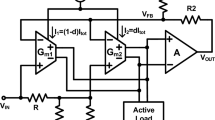Abstract
In this paper a new approach for controlling the gain of a programmable gain amplifier (PGA) using an eight-bit digital word has been proposed. Eight stages of R–2R ladder attenuators have been employed for attenuating the input signal. The output of the ladder network feeds the nine gm stages as a part of the PGA. Making use of three MSB bits of the control word, at each instance just the two successive gm stages are active whose tail currents are precisely determined to set the PGA linear gain in dB. A current bank composed of 32 current sources has been used for driving the tail currents of the active gm stages. The current sources that bias the active gm stages are controlled by the five LSB bits of the digital control word. Thanks to the proposed technique, the values of the current sources are determined so that the gain of the circuit is based on a ratio-metric parameter making the circuit less sensitive to process variations. For verification of the proposed idea, a differential PGA is design in a 0.18 µm 1.8 V CMOS technology. The gain of the designed circuit changes from 20.8 to −27.4 dB in 256 steps linearly in dB so that the maximum gain error respect to its ideal value is less than 0.03 dB in different corner cases. At the maximum gain, the bandwidth and the input referred noise voltage of the PGA are 150 MHz and 3.5 nv/√Hz, respectively, while the overall circuit draws 6 mA from a 1.8 V power supply.










Similar content being viewed by others
References
Christensen, D. A. (1988). Ultrasonic bioinstrumentation. New York: Wiley.
Ismail, A., & Abidi, A. A. (2005). A 3.1- to 8.2-GHz zero-IF receiver and direct frequency synthesizer in 0.18-µm SiGe BiCMOS formode-2MB-OFDMUWB communication. IEEE Journal of Solid State Circuits and Systems, 40(12), 2573–2582.
Elwan, H., Tekin, A., & Pedrotti, K. (2009). A differential-ramp based 65 dB linear VGA technique in 65 nm CMOS. IEEE Journal of Solid State Circuits and Systems, 44(9), 2503–2514.
Liu, H., Zho, X., Boon, C. C., & He, X. (2015). Cell-based variable-gain amplifiers with accurate dB-linear characteristic in 0.18 µm CMOS technology. IEEE Journal of Solid State Circuits and Systems, 50(2), 586–596.
Kang, S. Y., Ryu, S. T., & Park, C. S. (2012). A precise decibel-linear programmable gain amplifier using a constant current-density function. IEEE Transactions on Microwave Theory and Techniques, 60(9), 2843–2850.
Gilbert, B. (1991). A low-noise wideband variable-gain amplifier using an interpolated ladder attenuator. ISSCC Digest of Technical Papers, pp. 280–281.
El-Shennawy, M., Joram, N., & Ellinger, F. (2016). A 55 dB range gain interpolating variable gain amplifier with improved offset cancellation. In Proceedings of the PRIME.
El-Shennawy, M., Joram, N., & Ellinger, F. (2015). Techniques for maximizing input handling and improving linearity of gain interpolating VGAs. In Proceedings of the PRIME (pp. 1–4).
AD600/602datasheet. (2008). http://www.analog.com/media/en/technical-documentation/data-sheets/AD600/602.pdf. Analog Devices, Rev. F.
Wu, R., Makinwa, K. A. A., & Huijsing, J. H. (2009). A chopper current-feedback instrumentation amplifier with a 1 mHz 1/f noise corner and an AC- coupled ripple reduction loop. IEEE Journal of Solid State Circuits and Systems, 44(12), 3232–3243.
Author information
Authors and Affiliations
Corresponding author
Rights and permissions
About this article
Cite this article
Koolivand, Y., Shoaei, O. & Jafarabadi-Ashtiani, S. Linear in dB, sub 0.2 dB gain-step CMOS programmable gain amplifier for ultrasound applications. Analog Integr Circ Sig Process 93, 309–318 (2017). https://doi.org/10.1007/s10470-017-1016-1
Received:
Revised:
Accepted:
Published:
Issue Date:
DOI: https://doi.org/10.1007/s10470-017-1016-1




